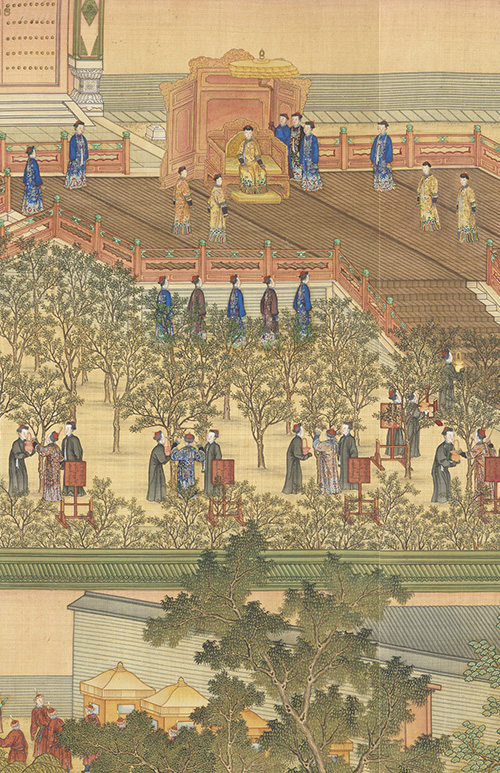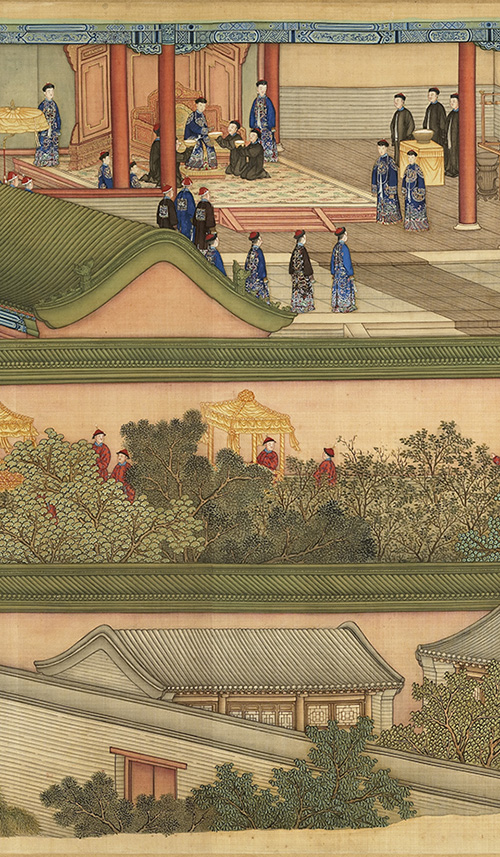Giuseppe Castiglione's portraits for the Qing court serve as authentic records of the ruling family, nobility, and meritorious officials. Under the aesthetic guidance of the Qianlong emperor, Castiglione's accuracy for their facial features and proportional relationships are combined with a consistent source of light to create shading and delicate descriptions that yield exceptional images of volume and presence. Although the portraits of Qianlong's empress Xiaoxian and his consort Huixian here are unsigned, stylistically speaking, they are most likely from the hand of Castiglione. The paintings of Qianlong on a hunting party and with bow and arrow depict the emperor at the Mulan grounds, emphasizing the Manchu attention on martial pursuits. Castiglione also worked with other court painters to produce a set of four handscrolls on the rites of silk farming that records the Xiaoxian empress overseeing the ceremonial picking of mulberry leaves and presentation of silkworm cocoons at the Western Gardens, manifesting importance attached by the court to not only agriculture, but also sericulture. In addition, Castiglione's paintings of the warriors Ayusi and Macang commemorate actual military conquests. Besides being masterpieces of art, they also testify to people and events of importance to the Qing court.
Court artists, Qing dynasty (1644-1911)
Imperial Rites of Sericulture (Scroll 3: “Picking Mulberry Leaves”)
- Handscroll, ink and colors on silk, 51 x 590.4 cm
The imperial rites of sericulture refer to an ancient set of rituals in traditional China conducted by the empress and palace ladies in spring to commence the making of silk but which had long since become obsolete. However, in 1742, during the Qianlong emperor’s reign, the rites were revived and an altar to the goddess of silkworms ordered for construction in the Western Gardens. Finished in 1744, a grand ceremony for the imperial rites of sericulture was led by Empress Xiaoxian with various consorts and princesses of the court. It was held annually thereafter. Empress Xiaoxian died in 1748, so the Qianlong emperor ordered the production of this set of four handscrolls for “Calling at the Altar,” “Sacrifices at the Altar,” “Picking Mulberry Leaves,” and “Offering Cocoons.” Although appearing as a record of this important ritual, it probably is more to commemorate the late empress, which is why she appears in all the scrolls except the first. In this exhibit are the last two scrolls. For “Picking Mulberry Leaves,” the empress is shown wearing festive robes and seated on a platform overlooking mulberry trees and women picking their leaves. The court artists who collaborated on this scroll included Giuseppe Castiglione, Jin Kun, Cheng Liang, and Ding Guanhe.
Court artists, Qing dynasty (1644-1911)
Imperial Rites of Sericulture (Scroll 4: “Offering Cocoons”)
- Handscroll, ink and colors on silk, 51 x 639.7 cm
The imperial rites on sericulture included the empress making an offering to the goddess of silkworms, personally attending to mulberry trees, and unrolling cocoon silk by hand. This handscroll on “Offering Cocoons” shows the empress wearing regular robes before the ritual unrolling of the cocoons is to occur; she is seated in the Hall of Cocoons to receive the cocoons. According to records, the drafts for this series of handscrolls were presented by the artist Jin Kun in 1749 for imperial review, but the signatures are headed by that of Giuseppe Castiglione. The faces of the empress and four consorts and princesses do not appear formulaic. In fact, the portrait of the empress is similar to others of Xiaoxian, the faces of these figures most likely coming from the hand of Castiglione. In other words, the scrolls were designed by Jin Kun, but Castiglione, who did the imperial portraits, is listed at the head of this collaborative project, a clear indication of the imperial favor that he enjoyed. At the end of this scroll is a lengthy inscription by the Qianlong emperor, in which he laments with endless longing for the late empress. The artists who did this painting were Giuseppe Castiglione, Jin Kun, Cheng Zhidao, and Li Huilin.



